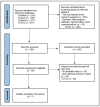Impact of Vitamin D on Osseointegration in Dental Implants: A Systematic Review of Human Studies
- PMID: 38257102
- PMCID: PMC10819660
- DOI: 10.3390/nu16020209
Impact of Vitamin D on Osseointegration in Dental Implants: A Systematic Review of Human Studies
Abstract
This systematic review evaluates the impact of Vitamin D levels on dental implant osseointegration, hypothesizing that optimal Vitamin D enhances success rates, and aims to synthesize data on its relationship with clinical outcomes in implantology. A comprehensive search across PubMed, Cochrane Library, and Web of Science databases included seven peer-reviewed articles meeting the criteria for the review. These studies, conducted between 2008 and 2021, included human subjects and explicitly correlated serum Vitamin D levels with dental implant outcomes, following PRISMA guidelines. The selected studies involved 1462 participants and examined 4450 dental implants. Key findings included a varied implant loss rate ranging from 3.9% to 11.4% across the studies. One study reported a 9.8% implant loss rate, yet found no significant association between Vitamin D receptor polymorphism and implant success. Another study indicated successful implantation following Vitamin D3 supplementation, even in severe deficiency cases. The highest implant loss rate (11.1%) was observed in severely Vitamin D-deficient patients, particularly when compounded by risk factors such as smoking and periodontal disease. Additionally, one study noted significantly improved bone density following post-surgical Vitamin D supplementation for up to 12 weeks. The review supports a link between sufficient Vitamin D levels and successful dental implant osseointegration, suggesting Vitamin D deficiency as a potential risk factor for increased failure and advocating for Vitamin D evaluations in pre-surgical planning to potentially enhance implantology outcomes.
Keywords: dental implants; dentistry; vitamin D.
Conflict of interest statement
The authors declare no conflicts of interest.
Figures
Similar articles
-
Does vitamin D have an effect on osseointegration of dental implants? A systematic review.Int J Implant Dent. 2022 Apr 11;8(1):16. doi: 10.1186/s40729-022-00414-6. Int J Implant Dent. 2022. PMID: 35403929 Free PMC article.
-
Vitamin D supplementation for sickle cell disease.Cochrane Database Syst Rev. 2017 Jan 20;1(1):CD010858. doi: 10.1002/14651858.CD010858.pub2. Cochrane Database Syst Rev. 2017. Update in: Cochrane Database Syst Rev. 2020 May 28;5:CD010858. doi: 10.1002/14651858.CD010858.pub3. PMID: 28105733 Free PMC article. Updated.
-
Interventions for replacing missing teeth: different times for loading dental implants.Cochrane Database Syst Rev. 2013 Mar 28;2013(3):CD003878. doi: 10.1002/14651858.CD003878.pub5. Cochrane Database Syst Rev. 2013. PMID: 23543525 Free PMC article.
-
Evaluating Micro-computed Tomography in Dental Implant Osseointegration: A Systematic Review and Meta-analysis.Acad Radiol. 2025 Feb;32(2):1086-1099. doi: 10.1016/j.acra.2024.09.011. Epub 2024 Oct 5. Acad Radiol. 2025. PMID: 39368915
-
Impact of diabetes mellitus and glycemic control on the osseointegration of dental implants: a systematic literature review.J Periodontol. 2009 Nov;80(11):1719-30. doi: 10.1902/jop.2009.090283. J Periodontol. 2009. PMID: 19905942
Cited by
-
Vitamin - D supplements for better osteointegration in dental implant surgery: A randomized control trial.Bioinformation. 2025 May 31;21(5):1245-1247. doi: 10.6026/973206300211245. eCollection 2025. Bioinformation. 2025. PMID: 40822803 Free PMC article.
-
The Critical Role of Trace Elements in Bone Health.Nutrients. 2024 Nov 13;16(22):3867. doi: 10.3390/nu16223867. Nutrients. 2024. PMID: 39599653 Free PMC article.
-
Correlation between vitamin D3 serum levels and jaw bone density of candidates for dental implant treatment using CBCT.J Dent Res Dent Clin Dent Prospects. 2025 Mar 31;19(1):40-45. doi: 10.34172/joddd.025.41648. eCollection 2025 Mar. J Dent Res Dent Clin Dent Prospects. 2025. PMID: 40464023 Free PMC article.
-
The Influence of Osteoporosis and Diabetes on Dental Implant Stability: A Pilot Study.Medicina (Kaunas). 2025 Jan 4;61(1):74. doi: 10.3390/medicina61010074. Medicina (Kaunas). 2025. PMID: 39859055 Free PMC article.
-
The Impact of LDL Cholesterol, HDL Cholesterol, Triglycerides, and Vitamin D on Short-Term Implant Survival Rate: A Prospective Observational Study.J Clin Med. 2025 May 18;14(10):3531. doi: 10.3390/jcm14103531. J Clin Med. 2025. PMID: 40429527 Free PMC article.
References
-
- Levin L., Pathael S., Dolev E., Schwartz-Arad D. Aesthetic versus surgical success of single dental implants: 1- to 9-year follow-up. Pract. Proced. Aesthet. Dent. 2005;17:533–538; quiz 540, 566. - PubMed
Publication types
MeSH terms
Substances
LinkOut - more resources
Full Text Sources
Medical



